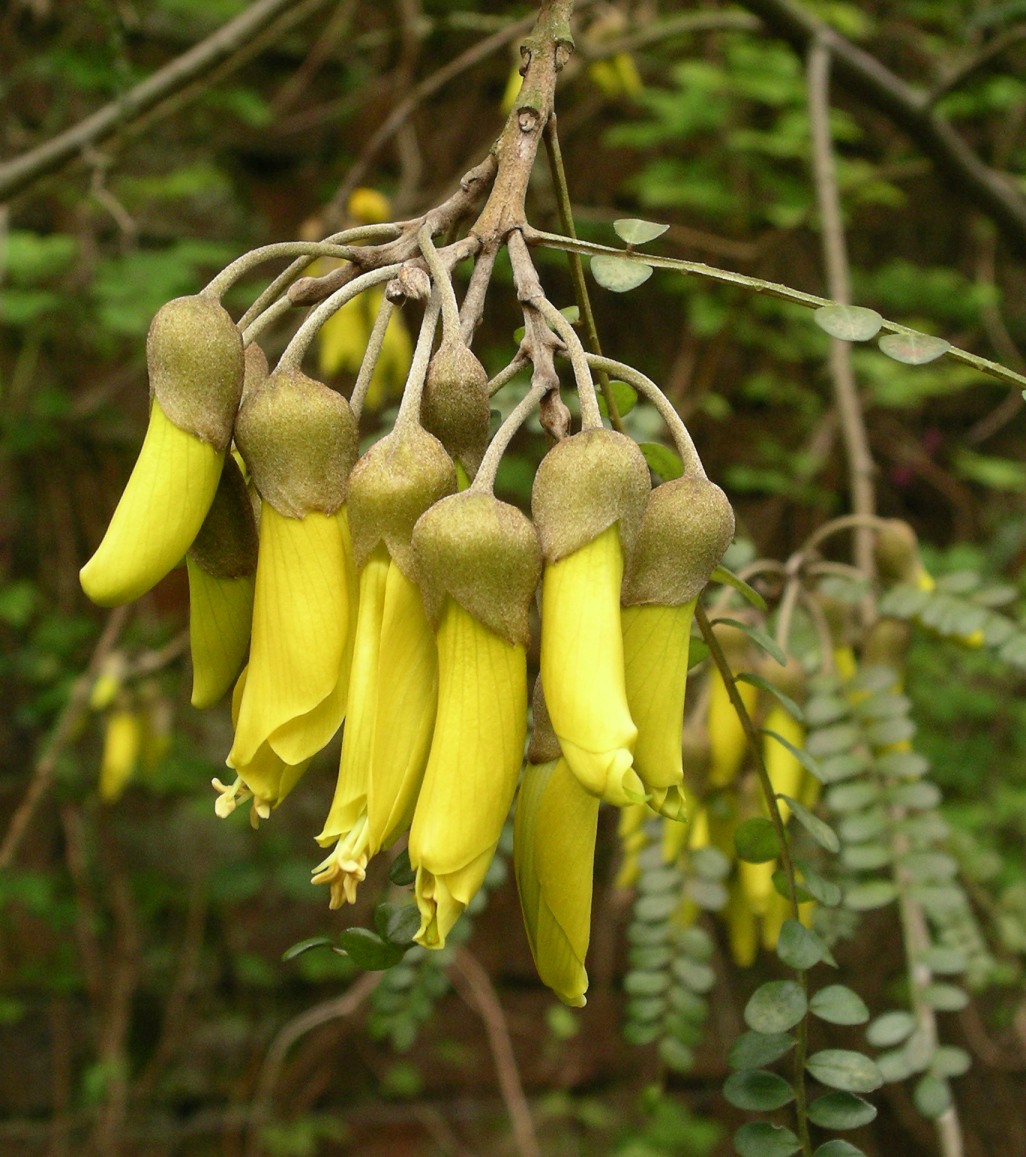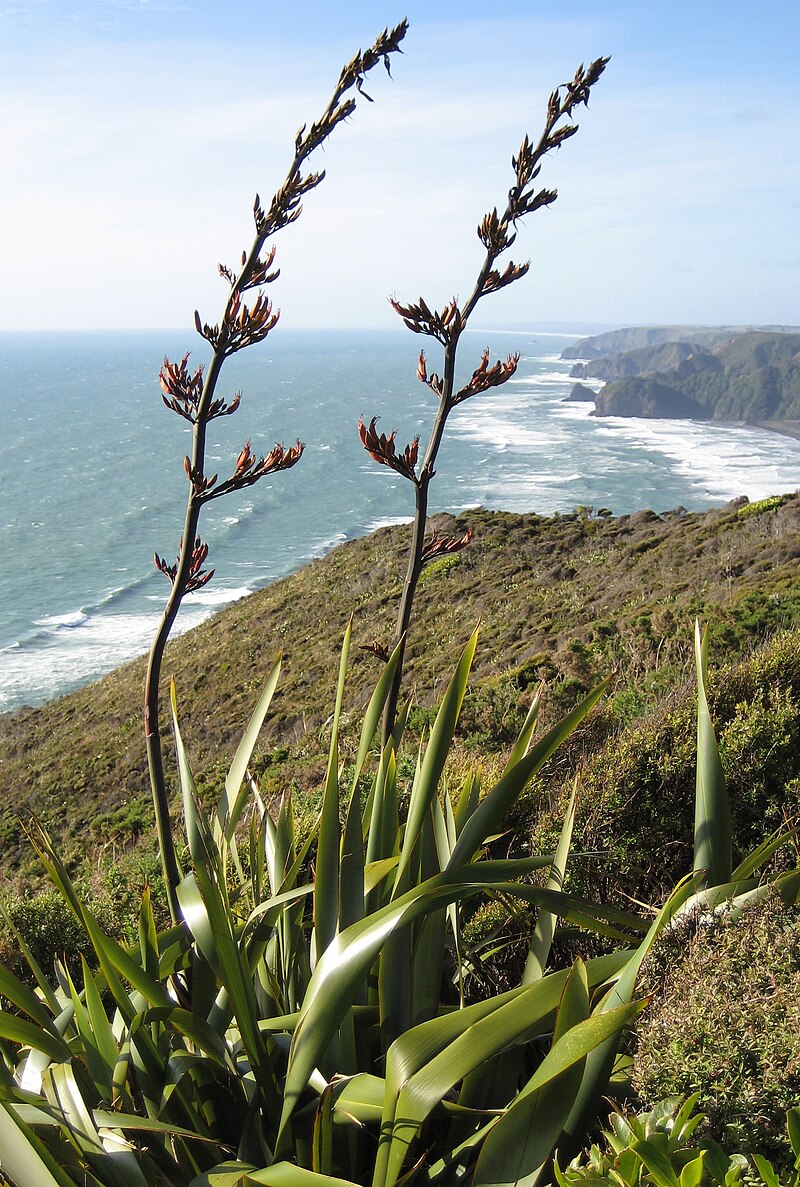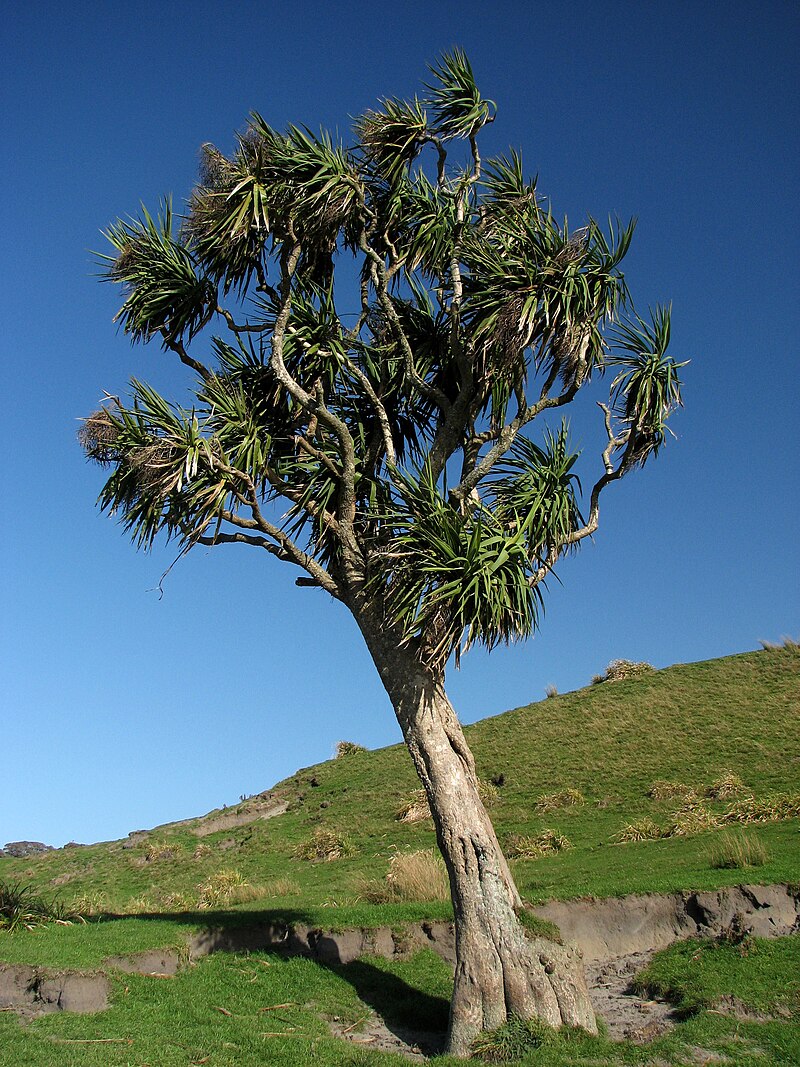Kōwhai (Sophora microphylla)
Sophora microphylla
The Kōwhai (Sophora microphylla) is considered New Zealand's unofficial national flower, beloved for its spectacular golden-yellow blooms that herald the arrival of spring. This small to medium-sized native tree features distinctive small leaflets on gracefully arching branches. When in full flower, usually between August and October, it creates one of the most stunning displays in the New Zealand landscape. The tree is not only ornamentally valuable but also ecologically important, providing crucial early-season nectar for native birds like tūī and bellbirds.

Image credit: Kōwhai (Sophora microphylla) displaying its characteristic golden-yellow flowers in early spring. Image by Sid Mosdell [CC BY 2.0], via Wikimedia Commons
Quick Facts
| Height | 4-8 meters |
|---|---|
| Water Needs | Low to Moderate |
| Light | Full sun to light shade |
| Frost Tolerance | High |
| Growth Rate | Slow to moderate |
| Lifespan | 50-100+ years |
Climate Best Suited To
Kōwhai is a hardy native tree found throughout New Zealand, from coastal areas to lower mountain slopes. It adapts to a range of conditions but prefers areas with:
- Temperature: Tolerates a wide range from -5°C to 30°C. Established trees have good frost hardiness.
- Moisture: Moderately drought-tolerant once established, but benefits from some moisture during extended dry periods.
- Light: Prefers full sun for best flowering, though tolerates partial shade. More open situations produce more compact growth and better flowering.
- Wind: Moderately wind-tolerant, handling coastal conditions and exposed sites reasonably well once established.
- Soil: Adaptable to most soil types but prefers well-draining conditions. Naturally occurs along riverbanks and forest margins.
Regional Suitability
| City | Climate Suitability |
|---|---|
| Whangārei | Ideal |
| Auckland | Ideal |
| Hamilton | Ideal |
| Tauranga | Ideal |
| Rotorua | Ideal |
| Gisborne | Ideal |
| New Plymouth | Ideal |
| Napier | Ideal |
| Whanganui | Ideal |
| Palmerston North | Ideal |
| Wellington | Ideal |
| Nelson | Ideal |
| Christchurch | Ideal |
| Dunedin | Good |
| Queenstown | Good |
| Invercargill | Moderate |
Kōwhai's climate adaptability makes it suitable for cultivation throughout most of New Zealand, with some extra care required in the coldest southern regions.
Growth Habit
Kōwhai has a distinctive growth habit and appearance:
- Form: Typically grows as a small to medium tree with a rounded canopy and often multiple trunks. Growth pattern may be upright or spreading depending on conditions.
- Branches: Slender, somewhat weeping or arching branches create a graceful silhouette. Young branches may have a zig-zag pattern.
- Foliage: Distinctive pinnate (feather-like) compound leaves comprising 8-40 small leaflets (5-8mm long), giving a delicate, lacy appearance. Foliage is typically evergreen but can be partially deciduous in colder regions.
- Bark: Develops distinctive corky, furrowed bark with maturity, adding winter interest.
- Flowers: Spectacular pendulous clusters of golden-yellow flowers (3-5cm long) appear in spring, often before or with new leaf growth, creating a dramatic display.
- Root System: Moderately deep-rooting with good anchoring capability, particularly when grown near waterways.
In its natural habitat, Kōwhai is often found along riverbanks, forest margins, and coastal areas where its flexible branches and sturdy roots help it withstand periodic flooding or coastal winds. It's relatively slow-growing in its early years but becomes more robust with age.
Propagation
Kōwhai can be propagated through several methods:
From Seed
The most common method, though it requires special preparation:
- Collect mature seed pods when they turn brown, usually in autumn to early winter.
- Seeds have a hard outer coating that requires scarification to germinate:
- Nick the seed coat with a file or sandpaper
- Pour hot (not boiling) water over seeds and soak for 24 hours
- Or freeze and thaw seeds several times
- Sow treated seeds in seed-raising mix at a depth of 1-2cm.
- Keep moist but not waterlogged at 15-20°C.
- Germination typically occurs within 2-4 weeks after treatment.
- Transplant seedlings when they have several true leaves.
From Cuttings
A more challenging but faster method:
- Take semi-hardwood cuttings in late summer or autumn.
- Use 10-15cm sections with a heel (a small section of older wood attached).
- Remove lower leaves and treat with rooting hormone.
- Insert into a mix of perlite and peat or similar free-draining medium.
- Maintain high humidity using a plastic cover or mist system.
- Bottom heat of 18-22°C improves success rate.
- Rooting may take 8-12 weeks or longer.
Grafting
Sometimes used for selected cultivars:
- Typically performed in late winter or early spring.
- Use seedling kōwhai rootstock.
- Whip and tongue or cleft grafting methods work well.
- Maintain grafted plants in a sheltered environment until union is established.
Note: Seedling-grown kōwhai can take 5-7 years to flower, while cutting or grafted plants may flower sooner.
Planting and Care
Planting
- When to Plant: Best planted in autumn or spring when soil is workable and temperatures are mild.
- Location: Choose a sunny position with some shelter from strong winds, especially for young plants.
- Soil Preparation: Well-draining soil is essential. Add compost to heavy clay soils to improve drainage.
- Spacing: Allow 3-5 meters between trees for mature spread.
- Depth: Plant at the same level as it was in its container, taking care not to bury the root collar.
Watering
- Water regularly during the first 2-3 growing seasons until established.
- Once established, kōwhai is relatively drought-tolerant but benefits from occasional deep watering during extended dry periods.
- Avoid overwatering which can lead to root diseases.
- A 5-10cm layer of mulch helps retain soil moisture and suppress weeds.
Fertilizing
- Kōwhai is adapted to New Zealand's naturally low-fertility soils and generally doesn't require heavy fertilization.
- Apply a slow-release native plant fertilizer in spring if growth seems poor.
- Avoid high-nitrogen fertilizers which can promote excessive foliage at the expense of flowering.
- An annual application of compost around the drip line provides gentle nutrition.
Maintenance
- Minimal pruning required - primarily to remove dead, damaged, or crossing branches.
- Can be shaped when young to establish a strong framework.
- Prune after flowering if necessary to maintain shape.
- Watch for self-sown seedlings which may appear around mature trees.
- Check periodically for seed pod borers or other pests.
Cultural Significance
Kōwhai holds important cultural significance in New Zealand:
Māori Significance
- The word 'kōwhai' refers to the bright yellow color of the flowers.
- Traditionally used in rongoā Māori (Māori medicine) - bark preparations treated internal pains, wounds, and bruising.
- The flowering of kōwhai was an important seasonal indicator, signaling it was time to plant kūmara (sweet potato).
- Wood was used for making tools, weapons, and construction due to its durability and strength.
- Branches were used for snaring birds and in house construction.
National Identity
- Kōwhai flowers are widely regarded as New Zealand's unofficial national flower.
- Commonly featured in New Zealand art, literature, and design.
- The vibrant yellow blooms symbolize spring and renewal in New Zealand culture.
- One of the most recognizable and beloved native plants among New Zealanders.
Historical Use
- Early European settlers recognized the ornamental value of kōwhai and incorporated it into gardens.
- The attractive timber was used for specialty woodworking and tool handles.
- Traditional ecological knowledge about kōwhai was shared between Māori and early botanists.
Today, kōwhai continues to be celebrated as a botanical icon of New Zealand, planted widely in public spaces, restoration projects, and home gardens as a symbol of national pride and natural heritage.
Landscaping Applications
Garden Uses
- Specimen Tree: Perfect as a focal point in smaller gardens with its spectacular spring display.
- Avenue Planting: Creates a dramatic effect when planted in a row along driveways or paths.
- Native Garden: Essential component of any New Zealand native planting scheme.
- Woodland Edge: Works well at forest margins or as transition between garden and wilder areas.
- Bird Garden: Excellent for attracting nectar-feeding birds, especially tūī and bellbirds.
- Stream or Pond Margins: Natural habitat includes riparian areas, making it suitable for waterside planting.
Design Considerations
- Consider the golden flower display when planning your garden color scheme - dramatic against dark backgrounds.
- The open, somewhat irregular growth habit creates dappled shade underneath, perfect for shade-tolerant understory plants.
- Deciduous or semi-deciduous flowering provides winter/early spring interest when other plants are dormant.
- The distinctive seed pods add textural interest after flowering.
- Relatively small root system makes it suitable for planting near structures.
Companion Planting
Kōwhai combines beautifully with other New Zealand natives such as:
- Phormium tenax (flax) - for contrasting foliage form
- Carex secta (pukio) - for waterside plantings
- Cordyline australis (cabbage tree) - for vertical accent
- Pittosporum tenuifolium (kohuhu) - for dark foliage contrast with flowers
- Coprosma species - for understory planting
- Astelia species - for textural ground cover beneath
For a stunning effect, underplant kōwhai with blue flowering natives like Wahlenbergia or Hebe species to create a complementary color contrast with the yellow flowers.
Pests and Diseases
While generally resilient, kōwhai can face several challenges:
Common Pests
- Seed Pod Borer (Stathmopoda sp.): Caterpillars that bore into and consume seeds. Control by collecting and disposing of affected pods.
- Leaf Miners: Tiny larvae that tunnel between leaf surfaces creating distinctive tracks. Generally not serious enough to warrant control.
- Scale Insects: May infest stems and branches. Control with horticultural oil if infestation is severe.
- Caterpillars: Various species may feed on foliage. Hand removal is usually sufficient.
Diseases
- Root Rot: Can occur in poorly drained soils. Ensure planting site has good drainage.
- Powdery Mildew: May appear as white powdery coating on leaves in humid conditions with poor air circulation. Rarely serious.
- Dieback: Occasionally branches may die back. Prune to healthy wood and improve tree vigor through proper care.
Environmental Issues
- Chlorosis: Yellowing leaves may indicate nutrient deficiencies, particularly iron in alkaline soils. Adjust soil pH if necessary.
- Frost Damage: Young plants may be damaged by severe frosts. Provide protection for the first few winters.
- Browsing: Rabbits and hares may damage young trees. Use protective guards until established.
Toxicity
All parts of kōwhai contain the toxin cytisine and should be considered poisonous if ingested, particularly the seeds. Keep out of reach of small children and pets. Despite this, there are few recorded cases of serious poisoning from kōwhai in New Zealand.
Seasonal Care Guide
Spring
- Enjoy the spectacular floral display, typically from August to October.
- Apply a slow-release fertilizer if needed once flowering is complete.
- Mulch around the base, keeping mulch away from the trunk.
- Look out for any pest activity as new growth emerges.
- An ideal time to plant new specimens.
Summer
- Water young trees deeply during dry periods.
- Established trees generally require minimal watering except in prolonged drought.
- Monitor for any signs of stress or pest issues.
- Seed pods develop and mature - collect for propagation if desired.
Autumn
- Another good time for planting.
- Collect mature seed pods for propagation.
- Light pruning can be done if needed to maintain shape.
- Apply another layer of mulch before winter to protect roots.
Winter
- Minimal care required during dormant period.
- Protection may be needed for young plants in frost-prone areas.
- A good time to look at the tree's structure and plan any necessary pruning.
- Prepare scarified seeds for spring sowing.
Ecological Impact
Kōwhai plays several important ecological roles in New Zealand's ecosystems:
- Nectar Source: The abundant nectar-rich flowers are a crucial early spring food source for native birds including tūī, bellbird, and kākā.
- Nitrogen Fixation: As a legume, kōwhai has root nodules containing bacteria that fix atmospheric nitrogen, enriching the soil.
- Erosion Control: The extensive root systems of kōwhai help stabilize streambanks and slopes.
- Habitat Provision: Provides nesting sites and shelter for various native birds and insects.
- Forest Succession: Acts as a pioneer or early successional species in some habitats, helping establish conditions for other native plants.
- Insect Support: Hosts various native insects, contributing to biodiversity.
In garden settings, kōwhai can significantly enhance local biodiversity by attracting nectar-feeding birds that may be rare visitors to urban and suburban areas. The spring flowering also provides an important food source for honeybees and native bees when few other nectar sources are available.
Including kōwhai in restoration plantings helps reestablish ecological connections and strengthens the resilience of native ecosystems. Its adaptability across different environments makes it a valuable component in ecological restoration projects throughout New Zealand.
Bonus Tip
Create a "Birds' Breakfast Nook" featuring kōwhai as the centerpiece:
Plant a kōwhai in a location visible from your home's windows. Beneath and around it, create a layered planting of complementary natives that extend the bird-feeding season beyond the kōwhai's spring flowering. Include flax (Phormium), kākābeak (Clianthus), mountain flax (Astelia), and fuchsia (Fuchsia excorticata) to provide nectar through different seasons.
Add a simple bird bath nearby and a few strategically placed perching branches to create perfect viewing spots for birds. This arrangement will not only give you a spectacular seasonal display, but also a ringside seat to observe tūī, bellbirds, and other nectar-feeding birds throughout the year. The contrast between the birds' dark plumage and the brilliant yellow kōwhai flowers creates stunning photo opportunities during the spring flowering period.


